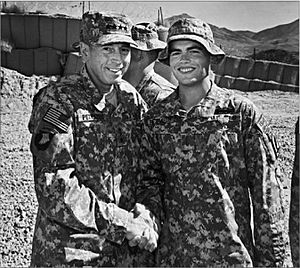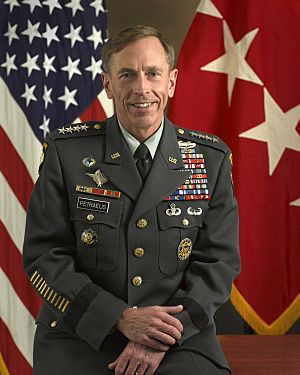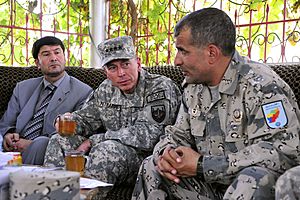David Petraeus facts for kids
Quick facts for kids
David Petraeus
|
|
|---|---|

Official portrait, 2011
|
|
| 4th Director of the Central Intelligence Agency | |
| In office 6 September 2011 – 9 November 2012 |
|
| President | Barack Obama |
| Deputy | Michael Morell |
| Preceded by | Leon Panetta |
| Succeeded by | John Brennan |
| Commander of the International Security Assistance Force | |
| In office 4 July 2010 – 18 July 2011 |
|
| Preceded by | Stanley A. McChrystal |
| Succeeded by | John R. Allen |
| Commander of United States Central Command | |
| In office 31 October 2008 – 30 June 2010 |
|
| Preceded by | Martin Dempsey (acting) |
| Succeeded by | John R. Allen (acting) |
| Personal details | |
| Born |
David Howell Petraeus
7 November 1952 Cornwall-on-Hudson, New York, U.S. |
| Political party | Republican (before 2002) Independent (since 2002) |
| Spouse |
Holly Knowlton
(m. 1974) |
| Children | 2 |
| Education | United States Military Academy (BS) Princeton University (MPA, PhD) |
| Military service | |
| Allegiance | United States |
| Branch/service | United States Army |
| Years of service | 1974–2011 |
| Rank | General |
| Commands | International Security Assistance Force United States Forces-Afghanistan United States Central Command Multinational Force-Iraq United States Army Combined Arms Center Fort Leavenworth Multinational Security Transition Command-Iraq 101st Airborne Division (Air Assault) 1st Brigade, 82nd Airborne Division 3rd Battalion, 187th Infantry Regiment |
| Battles/wars |
See list
|
| Awards | Defense Distinguished Service Medal (4) Army Distinguished Service Medal (3) Defense Superior Service Medal (2) Legion of Merit (4) Bronze Star with valor NATO Meritorious Service Medal Officer of the Order of Australia (More) |
David Howell Petraeus (born November 7, 1952) is a retired United States Army general and a former public official. He served for 37 years in the U.S. Army, becoming one of its most famous leaders. He is best known for commanding U.S. and allied forces in Iraq and Afghanistan.
After retiring from the military, Petraeus became the Director of the Central Intelligence Agency (CIA) in 2011. The CIA is the U.S. government agency that gathers information about foreign countries. He resigned from this position in 2012.
Petraeus was known for his intelligence and leadership. He graduated near the top of his class at the United States Military Academy at West Point. He later earned advanced degrees, including a Ph.D., from Princeton University. He has taught at several universities and is considered an expert on military strategy.
Contents
Early Life and Education
David Petraeus was born in Cornwall-on-Hudson, New York. His father was a sea captain from the Netherlands who came to the U.S. during World War II. His mother was an American librarian. Growing up, Petraeus attended Cornwall Central High School.

He then went to the U.S. Military Academy at West Point, a top college for training Army officers. He was a star student and athlete, playing on the soccer and ski teams. He graduated in the top 5% of his class in 1974.
At West Point, he met and married Holly Knowlton, the daughter of the general who was in charge of the academy. They have two children, a son and a daughter. Their son, Stephen, also became an Army officer.
After West Point, Petraeus continued his education. He earned a master's degree and a Ph.D. in international relations from Princeton University. He also taught at West Point and studied at Georgetown University. His studies helped him develop new ideas about modern warfare.
Military Career
Petraeus had a long and successful career in the U.S. Army, rising to the rank of a four-star general. He was known for his leadership and for developing new military strategies.
Early Assignments
After graduating from West Point in 1974, Petraeus became an infantry officer. He served in Italy with the 509th Airborne Battalion. He also served at Fort Stewart in Georgia.
During the 1990s, he commanded several units. He led the 3rd Battalion of the 187th Infantry Regiment, part of the famous 101st Airborne Division. In 1991, he was accidentally shot in the chest during a training exercise but recovered quickly. He later commanded a brigade in the 82nd Airborne Division.
Leading in the 21st Century
In the early 2000s, Petraeus served in Bosnia and Herzegovina as part of a NATO peacekeeping force. After the 9/11 attacks, he helped lead a counter-terrorism task force there.
His most famous roles came during the wars in Iraq and Afghanistan. He was promoted to general and became one of the most important military leaders of his time.
Involvement in the Iraq War
General Petraeus played a key role in the Iraq War. He led troops during the invasion and later commanded all coalition forces in the country.
Commander of the 101st Airborne Division
In 2003, Petraeus commanded the 101st Airborne Division during the invasion of Iraq. After Baghdad was captured, his division was sent to the city of Mosul. There, he used a new strategy to bring peace and stability.
Instead of just fighting, his soldiers worked to rebuild the city. They helped restart the economy, opened schools like the University of Mosul, and set up a local government. This approach of winning the "hearts and minds" of the people was a key part of his counterinsurgency strategy. Many people praised his work in Mosul.
The "Surge" in Iraq
By 2007, the situation in Iraq had become very violent. President George W. Bush announced a new plan called the "surge." This plan involved sending more U.S. troops to Iraq to improve security. He chose General Petraeus to lead this effort.
As the commander of all Multi-National Forces in Iraq, Petraeus put his counterinsurgency ideas into practice across the country. U.S. soldiers moved into neighborhoods to protect civilians and work with local Iraqi leaders. The goal was to separate the enemy from the population and build trust.
Under his command, violence in Iraq dropped significantly. Many people credit Petraeus and the surge strategy with improving conditions in the country. In September 2008, he handed over command in Iraq to General Raymond T. Odierno.
Commander in Afghanistan
In 2010, President Barack Obama asked Petraeus to become the top commander of U.S. and NATO forces in Afghanistan. This was another very challenging job.
In Afghanistan, Petraeus used a similar counterinsurgency strategy. He focused on protecting the Afghan people from the Taliban. He issued rules to his troops to be very careful to avoid harming civilians during military operations.
During his time as commander, documents recovered from Osama bin Laden's compound showed that the terrorist leader had plotted to assassinate Petraeus and President Obama.
Petraeus served as commander in Afghanistan for about a year. He retired from the Army on August 31, 2011, after 37 years of service.
Director of the CIA
Shortly after retiring from the military, President Obama nominated Petraeus to be the Director of the Central Intelligence Agency (CIA). The Senate confirmed him, and he was sworn in on September 6, 2011.
As CIA director, Petraeus was in charge of the nation's main spy agency. He was known as a demanding and detail-oriented leader. His time at the CIA was shorter than expected. In November 2012, he resigned from his position, stating that he had shown poor judgment in his personal life. He said his actions did not meet the standards expected of a leader.
Life After Public Service
After leaving the CIA, Petraeus has been involved in many different activities. He has worked for a global investment firm, KKR, since 2013. He is also a visiting professor at several universities, including the City University of New York, the University of Southern California, and Yale University.
He often gives speeches and writes articles about foreign policy, military strategy, and leadership. He has also been considered for other government positions, including U.S. Secretary of State.
Petraeus has remained an important voice on world events. He has commented on the U.S. withdrawal from Afghanistan and the Russian invasion of Ukraine, offering his expert opinions on these complex issues.
Awards and Recognition
Throughout his career, General Petraeus has received numerous awards for his service.
- Military Medals: He has been awarded the Defense Distinguished Service Medal, the Army Distinguished Service Medal, and the Bronze Star Medal.
- Foreign Awards: He has received honors from many countries, including Australia, France, Germany, and the Netherlands.
- Civilian Honors: Time magazine named him one of the 100 most influential people in the world. He has also received awards from many organizations for his leadership and public service.
See also
 In Spanish: David Petraeus para niños
In Spanish: David Petraeus para niños






